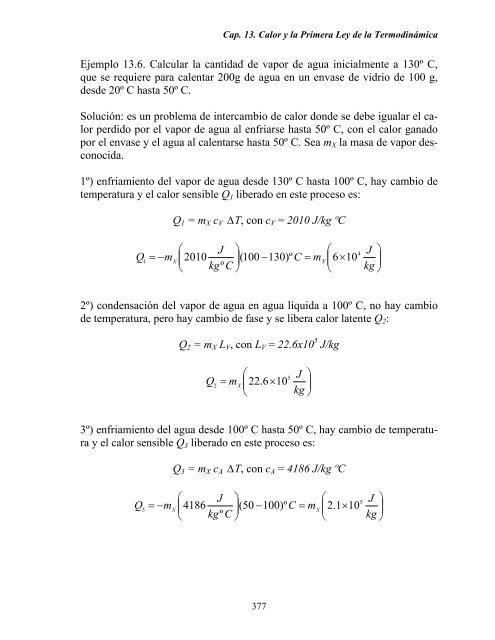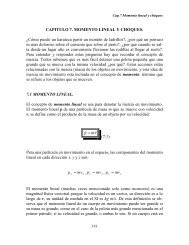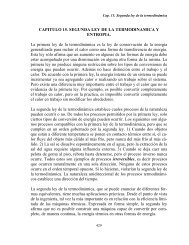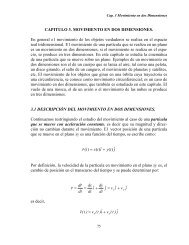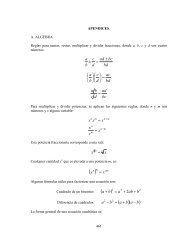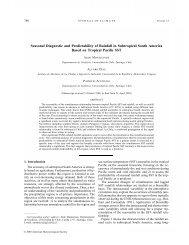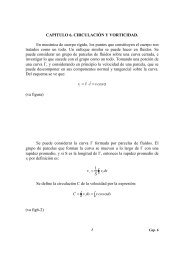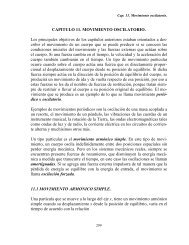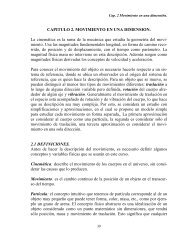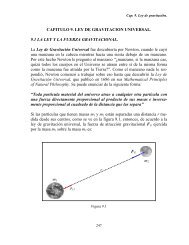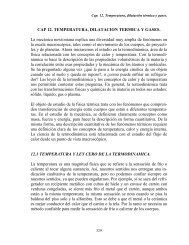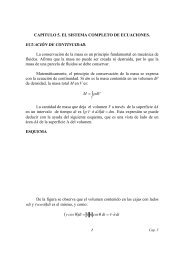Capítulo 13. Calor y la primera ley de - DGEO
Capítulo 13. Calor y la primera ley de - DGEO
Capítulo 13. Calor y la primera ley de - DGEO
Create successful ePaper yourself
Turn your PDF publications into a flip-book with our unique Google optimized e-Paper software.
Cap. <strong>13.</strong> <strong>Calor</strong> y <strong>la</strong> Primera Ley <strong>de</strong> <strong>la</strong> Termodinámica<br />
Ejemplo <strong>13.</strong>6. Calcu<strong>la</strong>r <strong>la</strong> cantidad <strong>de</strong> vapor <strong>de</strong> agua inicialmente a 130º C,<br />
que se requiere para calentar 200g <strong>de</strong> agua en un envase <strong>de</strong> vidrio <strong>de</strong> 100 g,<br />
<strong>de</strong>s<strong>de</strong> 20º C hasta 50º C.<br />
Solución: es un problema <strong>de</strong> intercambio <strong>de</strong> calor don<strong>de</strong> se <strong>de</strong>be igua<strong>la</strong>r el calor<br />
perdido por el vapor <strong>de</strong> agua al enfriarse hasta 50º C, con el calor ganado<br />
por el envase y el agua al calentarse hasta 50º C. Sea mX <strong>la</strong> masa <strong>de</strong> vapor <strong>de</strong>sconocida.<br />
1º) enfriamiento <strong>de</strong>l vapor <strong>de</strong> agua <strong>de</strong>s<strong>de</strong> 130º C hasta 100º C, hay cambio <strong>de</strong><br />
temperatura y el calor sensible Q1 liberado en este proceso es:<br />
Q1 = mX cV ∆T, con cV = 2010 J/kg ºC<br />
⎛ J ⎞<br />
⎛<br />
Q1 = −mX<br />
⎜2010<br />
⎟(<br />
100 −130)º<br />
C = mX<br />
⎜6<br />
× 10<br />
⎝ kgº<br />
C ⎠<br />
⎝<br />
2º) con<strong>de</strong>nsación <strong>de</strong>l vapor <strong>de</strong> agua en agua líquida a 100º C, no hay cambio<br />
<strong>de</strong> temperatura, pero hay cambio <strong>de</strong> fase y se libera calor <strong>la</strong>tente Q2:<br />
Q2 = mX LV, con LV = 22.6x10 5 J/kg<br />
⎛<br />
5<br />
Q2 = mX<br />
⎜22.<br />
6×<br />
10<br />
⎝<br />
3º) enfriamiento <strong>de</strong>l agua <strong>de</strong>s<strong>de</strong> 100º C hasta 50º C, hay cambio <strong>de</strong> temperatura<br />
y el calor sensible Q3 liberado en este proceso es:<br />
377<br />
J<br />
kg<br />
Q3 = mX cA ∆T, con cA = 4186 J/kg ºC<br />
⎛ J ⎞<br />
⎛<br />
5<br />
Q3 = −mX<br />
⎜4186<br />
⎟(<br />
50 −100)º<br />
C = mX<br />
⎜2.<br />
1×<br />
10<br />
⎝ kgº<br />
C ⎠<br />
⎝<br />
⎞<br />
⎟<br />
⎠<br />
4<br />
J<br />
kg<br />
J<br />
kg<br />
⎞<br />
⎟<br />
⎠<br />
⎞<br />
⎟<br />
⎠


